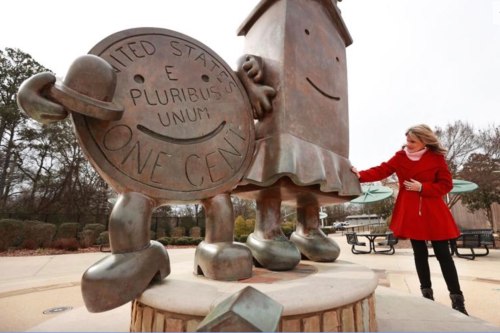
By DAVID HITT
May 3, 2024
As the artist Bill Watterson said, there’s treasure everywhere. And when the treasure is art, there’s an art to finding it.
For example, if you wanted to see the work of the bestselling Israeli artist in history, you could go to the Smithsonian. Or you could go to the GumTree Museum of Art in Tupelo. Museums in Northeast Mississippi – and within an easy daytrip’s drive – have a wealth of amazing artwork, and who better to share some highlights than the people who work with them.
The work of Israeli artist Yaacov Agam, for example, is a highlight of GumTree’s collection in the eyes of Sally Kepple, the museum’s executive director.
“The first time I saw Agam’s work was in the early ’80s at the Brooks Museum of Art in Memphis, Tennessee,” Kepple said. “I liked it then, and continue to like it today. While going through the GumTree Museum’s permanent collection, I was overjoyed to see that the Renasant Bank made a bequest of two of his pieces to the museum.
“His dynamic sculptures and three-dimensional paintings can also be found at the Smithsonian in Washington, D.C., the Parliament in Strasbourg, and at JFK airport. It is an honor to have his work in our collection.”
To see the work of Agam and many other artists, you can visit GumTree free from 10 a.m. to 4 p.m. Tuesday through Friday and 11 a.m. to 3 p.m. Saturdays.
If a highlight of Tupelo’s GumTree museum is an international star, one of the treasures from Ole Miss’ University Museum is from closer to home – a folk artist from Paris (Mississippi, that is).
“It’s very difficult to choose a favorite piece from the museum’s collection, as we house nearly 20,000 works of art and artifacts,” said Greta Koshenina, assistant curator at the museum, adding that one of her personal highlights was a piece by Theora Hamblett, a folk artist from Paris, who bequeathed her vast collection of paintings, mosaics, and ephemera to the University Museum.
“A recent donation from 2020 shows Hamblett’s ingenuity and use of household items, as the mosaic is built upon a tabletop. Much of Theora’s work has religious symbology and references her clairvoyant dreams and visions—this mosaic depicts the Creator’s Star. While Theora is most well-known for her brightly colored paintings of children’s games and dotted trees, she also created mosaics and glass ashtrays.”
The mosaic is currently on display in the Recent Acquisitions exhibition, on view until December. Hamblett’s work is on permanent display through rotating exhibits to showcase the plethora of her work housed at the museum. The museum is free to the public and open from 10 a.m. to 5 p.m. Tuesday through Friday and 10 a.m. to 4 p.m. Saturday.
Even more treasures lie in museums just a short drive from Northeast Mississippi:
In Memphis, you can visit the Brooks Museum of Art, one of the largest art museums in the South. The museum is open Wednesday through Sunday. Adult tickets are $15, but museum admission is free from 10 a.m. to noon every Saturday.
In Huntsville, Alabama, the Huntsville Museum of Art offers a variety of permanent and traveling exhibits, including a timeline of art history and a hands-on area for children. The museum is open Tuesday through Sunday. Adult tickets are $12; but the museum offers a special $5 price on Thursdays after 5 p.m.
In Birmingham, Alabama, the Birmingham Museum of Art houses a collection of more than 29,000 pieces, ranging from ancient times to today, representing cultures from around the world. The museum is open 10 a.m. to 5 p.m. Tuesday through Saturday and noon to 5 p.m. Sundays. General admission is free.
In Jackson, the Mississippi Museum of Art celebrates the state’s rich artistic heritage, complemented by noted artists from around the world. The museum is open 11 a.m. to 5 p.m. Tuesday through Saturday and 1 to 5 p.m. Sunday. Tickets are $15 for adults, but the museum always offers one exhibition with free admission.
Downtown Fulton's Playgarden Park features multiple pieces from renowned sculptor Tom Otterness. Known for his distinctive, whimsical style — with round-faced characters of cartoonish proportions — that belies some of the more serious undercurrents in his work, Otterness has become one of the most well-known public artists currently working. His art can be found across the world — in New York, St. Louis, California, Qatar and ... of course ... Fulton.